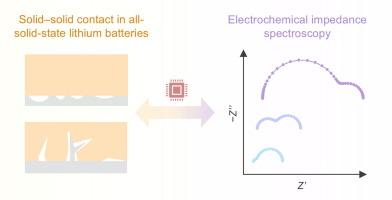揭示全固态锂电池中的固-固接触状态:从电化学阻抗谱的角度看问题
IF 13.1
1区 化学
Q1 Energy
引用次数: 0
摘要
全固态锂电池(ASSLBs)因其高能量密度和内在安全性而被视为下一代储能设备。锂金属和固体电解质之间的固-固接触对工作中的全固态锂电池的性能起着至关重要的作用,而通过实验方法对其进行定量研究则具有挑战性。本研究提出了一种基于有限元法的定量模型,用于模拟 ASSLB 中不同固-固接触状态的电化学阻抗谱。在等效电路模型和弛豫时间分布的帮助下,研究发现随着空隙数量和裂纹尖锐度的增加,接触电阻 Rc 越来越大,并最终主导电池阻抗。通过精确拟合,揭示了接触电阻 Rc 和(1 - 孔隙率)以及裂纹角度之间的反比例关系。这一贡献为阐明 ASSLB 中的固-固接触状态提供了新的视角。本文章由计算机程序翻译,如有差异,请以英文原文为准。

Unveiling solid-solid contact states in all-solid-state lithium batteries: An electrochemical impedance spectroscopy viewpoint
All-solid-state lithium batteries (ASSLBs) are strongly considered as the next-generation energy storage devices for their high energy density and intrinsic safety. The solid-solid contact between lithium metal and solid electrolyte plays a vital role in the performance of working ASSLBs, which is challenging to investigate quantitatively by experimental approach. This work proposed a quantitative model based on the finite element method for electrochemical impedance spectroscopy simulation of different solid-solid contact states in ASSLBs. With the assistance of an equivalent circuit model and distribution of relaxation times, it is discovered that as the number of voids and the sharpness of cracks increase, the contact resistance Rc grows and ultimately dominates the battery impedance. Through accurate fitting, inverse proportional relations between contact resistance Rc and (1 − porosity) as well as crack angle was disclosed. This contribution affords a fresh insight into clarifying solid-solid contact states in ASSLBs.
求助全文
通过发布文献求助,成功后即可免费获取论文全文。
去求助
来源期刊

Journal of Energy Chemistry
CHEMISTRY, APPLIED-CHEMISTRY, PHYSICAL
CiteScore
19.10
自引率
8.40%
发文量
3631
审稿时长
15 days
期刊介绍:
The Journal of Energy Chemistry, the official publication of Science Press and the Dalian Institute of Chemical Physics, Chinese Academy of Sciences, serves as a platform for reporting creative research and innovative applications in energy chemistry. It mainly reports on creative researches and innovative applications of chemical conversions of fossil energy, carbon dioxide, electrochemical energy and hydrogen energy, as well as the conversions of biomass and solar energy related with chemical issues to promote academic exchanges in the field of energy chemistry and to accelerate the exploration, research and development of energy science and technologies.
This journal focuses on original research papers covering various topics within energy chemistry worldwide, including:
Optimized utilization of fossil energy
Hydrogen energy
Conversion and storage of electrochemical energy
Capture, storage, and chemical conversion of carbon dioxide
Materials and nanotechnologies for energy conversion and storage
Chemistry in biomass conversion
Chemistry in the utilization of solar energy
 求助内容:
求助内容: 应助结果提醒方式:
应助结果提醒方式:


